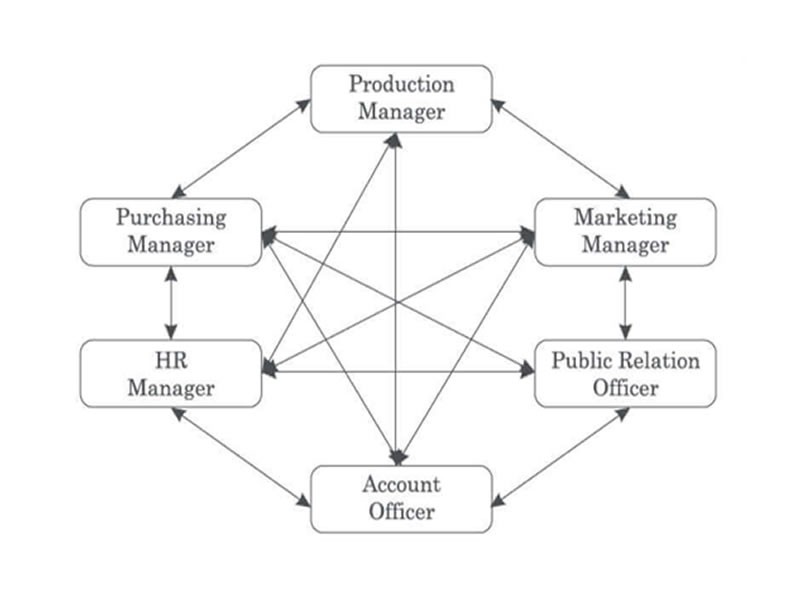Insight Blog
Agility’s perspectives on transforming the employee's experience throughout remote transformation using connected enterprise tools.
16 minutes reading time
(3140 words)
Featured
What Is Horizontal Communication? A Complete Guide
What is horizontal communication? its a key practice by enterprises to improve the sharing of information between employees.
Looking at the time and effort employees spend handling emails, presentations, and meetings, it is easy to see how effective organizational communication is for business success. Horizontal communication is one of the most significant means of communication in the organization. It is a key practice that businesses, ranging from start-ups to large-scale enterprises use to improve information sharing among employees.
In this guide, let us try to learn more about horizontal communication and explain what is horizontal communication examples, its benefits and challenges, the popular methods and the tools and practices to help improve communication in a workplace.
What is Horizontal Communication?
Horizontal communication is the practice of sharing information among employees from different departments in the organization at the same level of hierarchy. This mode of organizational communication is also called 'Lateral Communication' because the flow of information occurs laterally across departmental boundaries. Horizontal communication facilitates transmitting information across the organizational levels rather than pieces coming from top to down. The goal of this practice is to promote coordination and cooperation among employees with a similar rank, position, or status in the company. With this method, organizations aim to improve skills like problem-solving and teamwork by streamlining the flow of information among people at equal hierarchical levels.
Flow of Information in Horizontal Communication
Horizontal communication generally involves the coordination of information and allows people with the same position and status across departments to share messages and knowledge. Here is a graphical representation of horizontal communication.
The diagram shows how information flows horizontally among the same levels of employees in the organizational structure. Horizontal communication allows employees from different departments to cooperate in a collaborative work environment for the smooth functioning of the business and quick problem-solving.
Why Horizontal Communication is Getting More Popular?
Traditionally, large companies have hierarchical structures based on a vertical communication practice for information transmission. In this mode, orders and instructions are transmitted from top-level managers to the staff while employees share the responses with their managers. However, communication channels and methods have changed drastically over the past years with advancements in technology.
Today, chat applications, email, phone, and video conferencing along with newly emerging communication tools have transformed the way employees talk to one another. Anybody can share information with anybody else in seconds. This has automatically changed the way organizational communication is handled, making it more horizontal even with a vertical communication structure in place.
In the horizontal system of communication, there is coordination among people of the same position or rank in the organization and interaction among the managers of different departments. As every department unites to achieve the organizational objectives, the overall efficiency, and productivity of the business increase and it earns a higher profit.
When the departments, through effective communication and cooperation, come together, the company can fight any loss and convert it into profit. This is how horizontal communication works for the survival of a business environment. As the teams and departments work hand in hand for the organization's survival, it keeps growing in the right direction.
The information in this method of communication flows through all the departments and facilitates coordination among them. If somebody finds a problem with a message, they can directly discuss it with the person in charge and eliminate any misunderstanding. Moreover, as horizontal communication is performed in a one-on-one format, information transmission is faster and more interactive as compared to any other method.
One of the main reasons for its effectiveness is that it involves informal communication methods, making it easy to approach without undergoing any formalities. Thus, horizontal communication is highly diverse and dynamic and the ideas that come from it are more useful for the organization's growth as compared to any other type of organizational communication.
Key Characteristics of Effective Horizontal Communication
Let us discuss some of the fundamentals or the basics of horizontal communication.
Attentiveness Whenever somebody is trying to convey a message, it is important that the other person pays attention. Failing to concentrate well would result in missing some points and affect productivity. Lack of awareness can sometimes cause misunderstanding which is why attentive listening is crucial for effective communication.Ease of Understanding To make sure the communication is effective, it is essential that the message you try to convey is easily comprehended by the other person. The information should be simple enough that anybody receiving it understands it without any problem. It is also critical that any misunderstanding between the sender and the receiver is avoided as it can create unnecessary chaos.
Broad-Mindedness Narrow-mindedness can, at times, result in misinterpretation of the message communicated by others, further leading to conflicts and fights. This is called miscommunication. To avoid any such issue and ensure effective communication, the person receiving the information should have a broad-minded attitude.
Memory This is the most important principle that decides the effectiveness of horizontal communication. A person must be able to recall the conversation he had with the other person so that the communication runs smoothly between them.
Discipline To maintain effective communication, discipline should be maintained strictly at all levels. A failure to do so can create gaps in the work environment.
These are some of the factors that affect how effectively people at the same organizational level converse with each other.
Advantages of Horizontal Communication
Improving horizontal communication is one of the biggest organizational trends today as this method offers amazing advantages including:
Coordination the most significant objective of horizontal communication, coordination between teams and departments ensures smooth functioning of business operations. Lack of coordination can affect the business performance adversely. Horizontal communication helps authorities promote coordination among different departments thereby improving the overall efficiency and productivity.
No distortion As horizontal communication occurs between employees in the same level of the hierarchy, messages are passed directly and there is no risk of information getting misinterpreted or distorted.
Quick communication Horizontal communication happens more quickly as compared to other communication methods as the information flows within the same levels of managers and there are no formal layers.
Instant problem-solving With a speedy information transmission, this type of communication helps solve any issues quickly within the organization.
Dynamism This mode of communication also helps establish a dynamic work environment as all the employees across departments work in coordination. One of the most important objectives of horizontal communication is to introduce a congenial working atmosphere in the organization.
Satisfaction One of the biggest benefits of horizontal communication is improved job satisfaction in the organization. By promoting a favorable working atmosphere and morale upliftment, this organizational communication changes how employees feel about their jobs.
No misunderstanding Conflicts occur among the departmental heads in the organization at times. Horizontal communication can contribute to eliminating such misunderstandings and conflicts. It also helps the management improve cooperation and mutual relationships, which are inevitable factors for the success of the organization.
Limitations of Horizontal Communication
There are a few things you should consider before implementing horizontal communication in your organization.
Loss of control A big disadvantage of horizontal communication is that the process involves team leaders and members and there is little to no authority. This can result in loss of control which can ultimately slow down productivity.Conflict This type of communication can also create conflict between employees and teams communicating with each other. Disagreements and disputes can arise as the hierarchical structure is loosely defined. Rivalry can, at times, increase so much that employees start to avoid sharing information intentionally.
Reduced motivation Lack of motivation in one person or department can affect the motivation of others in this type of communication system. Moreover, the members are not motivated enough to go that extra mile the structure requires and thereby make it a failure.
Lack of coordination As the information exchange occurs between people across the same levels, there can be a lack of cooperation and communication with other levels in the organizational hierarchy.
Information overload Because this system does not process the information a lot, it can sometimes lead to overload as you sort through too much data to find the required details.
Wastage of time This type of communication can be time-consuming for high-level employees as they need to sort through a lot of data. More time may be consumed when vertical communication is needed to work on the decisions made during horizontal communication or confirm the information obtained through this mode.
Reduced productivity Most of the time, employees may not be ready to put extra effort into the system, thereby wasting valuable time of their managers and lowering the overall productivity.
Methods of Horizontal Communication
An organization can implement horizontal communication in one of the two ways:
Oral CommunicationThis type of communication includes conveying information through phone calls, speech, video calls, face-to-face conversations, etc. This mode is highly effective as the speaker and the listener are in direct contact with each other. The chances of misunderstanding reduce to a great extent when interacting orally.
Most organizations find this horizontal communication method effective and follow it in their workplace. An example of this system is the meetings held in the business organization. The only limitation of this method is that there is a chance of losing information if the listener does not maintain a record or evidence of the communication. However, some businesses still prefer this old-school form of communication.
Written CommunicationWritten communication is the most traditional method preferred for vertical communication. Though oral communication is more prominent in the horizontal system, written communication also plays a vital role. This form of communication involves transmitting information through printed media like email, applications, and letters. However, writing good email content is not enough so, by using a DKIM generator, staff should ensure the email message gets delivered properly. This method is known to be highly effective because the information received from the sender has evidence and nobody can deny written records at the time of conflicts.
Due to this benefit, a lot of organizations still use this form of communication. However, there is a drawback to this system as well. If a piece of information is lost or destroyed, it is impossible to retain the data and the organization suffers. Both these forms of horizontal communication are crucial for the efficient working of an organization. A combination of oral and written communication promotes smooth functioning of the business workplace.
Examples of Horizontal Communication
An example of horizontal communication is the interaction within a team where members work together in coordination to achieve goals and solve problems. This type of communication generally takes place between departmental heads in a company. They communicate with one another constantly to ensure the smooth functioning of the organization.
To understand this form of organizational communication, consider a company where the sales department head always ensures there is enough stock available for the team to accept orders. For this, he should keep interacting with the stores manager. The stores manager, in turn, maintains constant communication with the finance manager to make sure all the purchase orders are paid on time.
The finance head of the company constantly stays in touch with the collection head to see that the company has sufficient capital to keep the purchase department running well. This type of cooperation between people with similar roles and positions in the organization is referred to as horizontal communication.
Horizontal Communication Tools
Horizontal communication is common in today's workplace. As a lot of work is done online nowadays, people use different tools to interact with their co-workers. Advancements in technology have made it easy to implement a horizontal flow of information among people working across departments in the company.
Let us talk about some of the tools used in the organization to implement and encourage horizontal communication.
Presentations Presentations are a formal way of horizontal communication used by all the management levels to find out how effective an idea is. While it is an excellent way to convey your thoughts, you should tailor the speech properly because managers and even directors generally attend presentations.
Brainstorming This is a highly significant form of horizontal communication where everybody gets a chance to speak their mind and share their ideas with the entire team, including the manager.
Meetings Whether held for strategy planning or status updates, meetings are generally handled by managers to coordinate tasks and monitor performance. Teams can also hold meetings for informal interaction including team building activities like games and quizzes.
There are several other tools that follow a horizontal communication flow. Different organizations use creative ways to engage the employees and boost coordination. This also helps build interpersonal skills to assure good workplace relationships and mutual trust.
Formal & Informal Communication
Formal communication is the one that conveys information through predefined channels in the organization. An informal communication, on the other hand, is a form of communication in which information flows in all directions freely throughout the organization. Horizontal communication also uses formal as well as informal tools for effective coordination.
Formal communication is often used exclusively in any workplace and the employees strictly follow it as a part of their job. It can be either bottom-up, top-down, diagonal, or horizontal. Some of the most common examples of this form of interaction include reports, orders, requests, etc.
Informal communication does not follow any specific channel for information transmission. Such interaction occurs freely in all directions and is rapid and effective. Informal communication is quite common in any organization as people share ideas about different topics with their co-workers.
Grapevine Communication
One of the most popular types of informal horizontal communication, grapevine occurs in every company, regardless of the industry and size. Unlike intranets, emails, and other modes of formal communication, the grapevine is an informal way to interact and is inevitable for the success of a company. It creates a significant impact on employee experience and your business performance and helps build trust and mutual understanding among employees.
Through the grapevine, information flows in different directions and links everybody within the organization. It is not controlled by any rules or formalities but governed by personal and social relationships. It works through both internal and external channels and can operate horizontally, vertically, or diagonally.
Grapevine communication occurs in one of the four ways:
- Single Strand Chain – the message is conveyed to the final recipient through a line of people
- Gossip Chain – a person in the center passes the information to everybody else just like a wheel
- Probability Chain – it is a random process where one person passes the information to others and these people further pass the information
- Cluster Chain – a person conveys the message to selected people who further pass it to other selected people
Organizations today permit their employees to communicate freely with one another which gives a chance to activate grapevine communication. While there are perks and dangers to this form of communication, the organization can consider some practices to limit the negative effects of this method and benefit the workplace.
Water Cooler Talk
Another common form of informal horizontal communication is the water cooler talk that refers to casual discussions between employees. Though this type of interaction gets a bad rap with some companies, modern organizations are understanding the beauty and benefits of this type of interaction that gives the employees a chance to build interpersonal relationships and strengthen the workplace culture.
Water cooler talks help build strong company culture by uniting people on a personal level. This type of communication is powerful enough to build support, comfort, and retention for the employees. It also eliminates the barriers between team members, builds mutual trust, and streamlines collaboration. Water cooler talk can prove to be a great way to improve workplace productivity. As employees get a chance to de-stress between work, they have a fresh mindset and get more work done in lesser time.
These days, companies encourage this type of informal communication for their remote employees to help them know each other in absence of a physical work environment. Giving time to talk to peers helps build mutual relationships between employees, which in turn, improves morale and engagement in the workplace.
How to Improve Horizontal Communication
Though horizontal communication occurs in every organization in various ways and there is no way to stop it, organizations can follow some practices to enhance the benefits and eliminate the downsides. Let us look at some of the best practices to improve horizontal communication in the workplace.
Create a feedback generation plan Depending on the project, you can put a limit on the amount of time spent communicating between departments. You can also schedule regular meetings where problems and ideas are discussed. You can also ask for feedback from the employees about horizontal communication in the organization. Set the example so that other departments can solicit feedback on the communication among peers.Use a flowchart of organizational hierarchy Create a flowchart that outlines the structure of the organization and includes details of communication between departments in terms of frequency and time of contact. This will help management understand the basis for horizontal communication.
Engage employees in two-way communication Companies with strict hierarchical structures face challenges as employees don't feel like talking about their needs, raising questions, or sharing their voice. Organizations should work on building a company culture of open conversation where employees feel free to speak up. Employers are looking for ways to create engaging content and give the employees the ability to join conversations to drive a healthy relationship between peers, regardless of their location.
Eliminate information overload Today, employees deal with information overload where it is difficult to filter and consume content coming from reliable sources. Horizontal communication methods can help in this case. The leaders should keep the employees informed and updated with the latest information from reliable sources. Automating content import from trustworthy sources will make sure there is less room for rumors in the workplace.
Engage employees in two-way communication Companies with strict hierarchical structures face challenges as employees don't feel like talking about their needs, raising questions, or sharing their voice. Organizations should work on building a company culture of open conversation where employees feel free to speak up. Employers are looking for ways to create engaging content and give the employees the ability to join conversations to drive a healthy relationship between peers, regardless of their location.
Eliminate information overload Today, employees deal with information overload where it is difficult to filter and consume content coming from reliable sources. Horizontal communication methods can help in this case. The leaders should keep the employees informed and updated with the latest information from reliable sources. Automating content import from trustworthy sources will make sure there is less room for rumors in the workplace.
Conclusion
Horizontal communication is the most used and effective mode of interaction among the people at the same hierarchical level in the organization. As it improves coordination and facilitates growth, it is used as a popular communication method, even in today's digitalized world where most employees work remotely. To overcome the challenges in modern workplaces, it is important to use the right tools to make horizontal communication easy and efficient. Businesses should have the right channels to promote a flexible, healthy work environment where employees can easily collaborate and share information.
Categories
Blog
(2594)
Business Management
(318)
Employee Engagement
(206)
Digital Transformation
(172)
Intranets
(119)
Growth
(118)
Remote Work
(61)
Sales
(48)
Collaboration
(37)
Culture
(29)
Project management
(29)
Customer Experience
(26)
Knowledge Management
(21)
Leadership
(20)
Comparisons
(5)
Ready to learn more? 👍
One platform to optimize, manage and track all of your teams. Your new digital workplace is a click away. 🚀
Free for 14 days, no credit card required.















